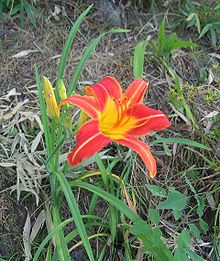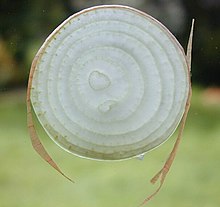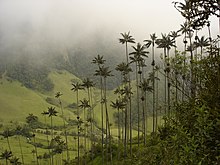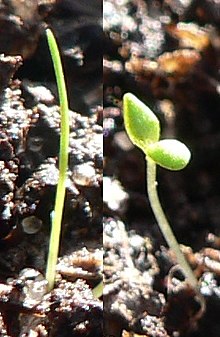
| Home | Sources Directory | News Releases | Calendar | Articles | | Contact | |
Monocotyledon
| This article may be expanded with text translated from the corresponding article in Spanish Wikipedia. (December 2009) After translating, {{Translated|es|Liliopsida}} must be added to the talk page to ensure copyright compliance.Translation instructions – Translate via Google |
| Monocotyledons Fossil range: Early Cretaceous - Recent |
|
|---|---|
 |
|
| Hemerocallis flower, with three flower parts in each whorl | |
| Scientific classification | |
| Kingdom: | Plantae |
| (unranked): | Angiosperms |
| (unranked): | Monocots |
| Orders | |
|
About 10; see text |
|

Monocotyledons, also known as monocots, are one of two major groups of flowering plants (or angiosperms) that are traditionally recognized, the other being dicotyledons, or dicots. Monocot seedlings typically have one cotyledon (seed-leaf), in contrast to the two cotyledons typical of dicots. Monocots have been recognized at various taxonomic ranks, and under various names (see below). The APG II system recognises a clade called "monocots" but does not assign it to a taxonomic rank.
There are between 50,000 and 60,000 species within this group; according to IUCN there are 59,300 species.[1] The largest family in this group (and in the flowering plants as a whole) by number of species are the orchids (family Orchidaceae), with more than 20,000 species.[2] In agriculture the majority of the biomass produced comes from monocots.[3] The true grasses, family Poaceae (Gramineae), are the most economically important family in this group. These include all the true grains (rice, wheat, maize, etc.), the pasture grasses, sugar cane, and the bamboos. True grasses have evolved to become highly specialised for wind pollination. Grasses produce much smaller flowers, which are gathered in highly visible plumes (inflorescences). Other economically important monocot families are the palm family (Arecaceae), banana family (Musaceae), ginger family (Zingiberaceae) and the onion family Alliaceae, which includes such ubiquitously used vegetables as onions and garlic.
Many plants cultivated for their blooms are also from the monocot group, notably lilies, daffodils, irises, amaryllis, orchids, cannas, bluebells and tulips.
Contents |
[edit] Name, characters
The name monocotyledons is derived from the traditional botanical name Monocotyledones, which derives from the fact that most members of this group have one cotyledon, or embryonic leaf, in their seeds. By contrast, the traditional dicotyledons typically have two cotyledons. From a diagnostic point of view the number of cotyledons is neither a particularly handy (as they are only present for a very short period in a plant's life), nor totally reliable character.
Nevertheless, monocots are a distinctive group.[4] One of the most noticeable traits is that a monocot's flower is trimerous, with the flower parts in threes or in multiples of three. That is to say, a monocotyledon's flower typically has three, six, or nine petals. Many monocots also have leaves with parallel veins.

[edit] Evolution
Monocots evolved from a single ancestor, and are younger than dicots, from which they probably branched off, as recent genetic research has shown. They evolved 100-120 million years ago, shortly after the flowering plant explosion.
[edit] Morphology, compared to the (broadly defined) dicotyledons
The traditionally listed differences between monocotyledons and dicotyledons are as follows. This is a broad sketch only, not invariably applicable, as there are a number of exceptions. The differences indicated are more true for monocots versus eudicots.[4]
| Feature | In monocots | In dicots |
|---|---|---|
| Number of parts of each flower | in threes (flowers are trimerous) | in fours or fives (tetramerous or pentamerous) |
| Number of furrows or pores in pollen | one | three |
| Number of cotyledons (leaves in the seed) | one | two |
| Arrangement of vascular bundles in the stem | scattered | in concentric circles |
| Roots | are adventitious | develop from the radicle |
| Arrangement of major leaf veins | parallel | reticulate |
A number of these differences are not unique to the monocots. For example, trimerous flowers and monosulcate pollen are also found in magnoliids.[4] Exclusively adventitious roots are found also in Nymphaeaceae and some of the Piperaceae.[4] Similarly, at least one of these traits, parallel leaf veins, is far from universal among the monocots. Monocots with reticulate leaf veins are found in a wide variety of monocot families: for example, Trillium, Smilax (greenbriar), and Pogonia (an orchid), and the Dioscoreales.[4] Nevertheless, this list of traits is a generally valid set of contrasts, especially when contrasting monocots with eudicots rather than non-monocot flowering plants in general.[4]
[edit] Emergence
Some monocots, such as grasses, have hypogeal emergence, where the mesocotyl elongates and pushes the coleoptile (which encloses and protects the shoot tip) toward the soil surface.[5] Since elongation occurs above the cotyledon, it is left in place in the soil where it was planted. Many dicots have epigeal emergence, the hypocotyl elongates and becomes arched in the soil. As the hypocotyl continues to elongate, it pulls the cotyledons upward, above the soil surface.
[edit] Vascular system

Monocots have a distinctive arrangement of vascular tissue known as an atactostele in which the vascular tissue is scattered rather than arranged in concentric rings. Many monocots are herbaceous and do not have the ability to increase the width of a stem (secondary growth) via the same kind of vascular cambium found in non-monocot woody plants.[4] However, some monocots do have secondary growth, and because it does not arise from a single vascular cambium producing xylem inwards and phloem outwards, it is termed "anomalous secondary growth".[6] Examples of large monocots which either exhibit secondary growth, or can reach large sizes without it, are palms (Arecaceae), screwpines (Pandanaceae), bananas (Musaceae), Yucca, Aloe, Dracaena, and Cordyline.[4]
[edit] Classification
The monocots are considered to form a monophyletic group arising early in the history of the flowering plants. The earliest fossils presumed to be monocot remains date from the early Cretaceous period.
Taxonomists have considerable latitude in naming this group, as the monocots are a group above the rank of family. Article 16 of the ICBN allows either a descriptive name or a name formed from the name of an included family.
Historically, the monocotyledons were named:
- Monocotyledoneae in the de Candolle system and the Engler system.
- Monocotyledones in the Bentham & Hooker system and the Wettstein system
- class Liliopsida in the Takhtajan system and the Cronquist system.
- subclass Liliidae in the Dahlgren system and the Thorne system (1992).
- clade monocots in the APG system and the APG II system.
Each of the systems mentioned above use their own internal taxonomy for the group. The monocotyledons are famous as a group that is extremely stable in its outer borders (it is a well-defined, coherent group), while in its internal taxonomy is extremely unstable (historically no two authoritative systems have agreed with each other on how the monocotyledons are related to each other).
Recent molecular studies have both confirmed the monophyly of the monocots and helped elucidate relationships within this group. The APG II system does not assign the monocots to a taxonomic rank, instead recognizing a monocots clade. This system recognizes ten orders of monocots and two families of monocots (Petrosaviaceae and Dasypogonaceae) not yet assigned to any order. More recently, the Petrosaviaceae has been included in the Petrosaviales, and placed near the lilioid orders.[7] The family Hydatellaceae, assigned to order Poales in the APG II system, has since been recognized as being misplaced in the monocots, and instead proves to be most closely related to the water lilies, family Nymphaeaceae.
clade monocots :
|
|
||||||||||||||||||||||||||||||||||||||||||||||||||||||||||||||||||
| The current phylogeny and composition of the monocots.[8] | |||||||||||||||||||||||||||||||||||||||||||||||||||||||||||||||||||
[edit] Notes
| This article needs additional citations for verification. Please help improve this article by adding reliable references. Unsourced material may be challenged and removed. (February 2008) |
- ^ [1]
- ^ Peter H. Raven; Ray Franklin Evert; & Susan E. Eichhorn. (2005) Biology of Plants–Ž, 7th ed., page 459
- ^ Reed, Barbara (2008). Plant cryopreservation a practical guide. New York: Springer. pp. 241. ISBN 978-0-387-72276-4. http://www.springerlink.com/content/u1gt1354336rr343/.
- ^ a b c d e f g h Mark W. Chase (2004). "Monocot relationships: an overview". American Journal of Botany 91: 1645'1655. doi:10.3732/ajb.91.10.1645. http://www.amjbot.org/cgi/content/full/91/10/1645.
- ^ Radosevich, Steven R.; Holt, Jodie S.; Ghersa, Claudio (1997). Weed ecology: implications for management. New York: J. Wiley. ISBN 0-471-11606-8. http://books.google.com/?id=uK9R7N-QaJMC&pg=RA1-PA149.
- ^ Donoghue, Michael J. (2005). "Key innovations, convergence, and success: macroevolutionary lessons from plant phylogeny". Paleobiology 31: 77. doi:10.1666/0094-8373(2005)031[0077:KICASM]2.0.CO;2. ISSN 0094-8373. http://www.phylodiversity.net/donoghue/publications/MJD_papers/2005/149_MJD_Paleo05.pdf.
- ^ Cantino, Philip D.; James A. Doyle, Sean W. Graham, Walter S. Judd, Richard G. Olmstead, Douglas E. Soltis, Pamela S. Soltis, & Michael J. Donoghue (2007). "Towards a phylogenetic nomenclature of Tracheophyta". Taxon 56 (3): E1'E44.
- ^ "An update of the Angiosperm Phylogeny Group classification for the orders and families of flowering plants: APG III". Botanical Journal of the Linnean Society 161: 105'121. 2009. doi:10.1111/j.1095-8339.2009.00996.x.
[edit] References
- Jerrold I. Davis, Dennis W. Stevenson, Gitte Petersen, Ole Seberg, Lisa M. Campbell, John V. Freudenstein, Douglas H. Goldman, Christopher R. Hardy, Fabian A. Michelangeli, Mark P. Simmons, Chelsea D. Specht, Francisco Vergara-Silva, Maria Gandolfo (2004). "A Phylogeny of the Monocots, as Inferred from rbcL and atpA Sequence Variation, and a Comparison of Methods for Calculating Jackknife and Bootstrap Values". Systematic Botany 29 (3): 467'510. doi:10.1600/0363644041744365. http://epmb.berkeley.edu/vfs/PIs/Specht-CD/web/SystBot.pdf. Retrieved 2007-08-24.
- Chase MW, Soltis DE, Soltis PS, Rudall PJ, Fay MF, Hahn WJ, Sullivan S, Joseph J, Molvray M, Kores PJ, Givnish TJ, Sytsma KJ, Pires JC (2000). Higher-level systematics of the monocotyledons: An assessment of current knowledge and a new classification. In: Wilson KL, Morrison DA, eds. Monocots: Systematics and Evolution.. CSIRO, Melbourne. 3'16. ISBN 0-643-06437-0
[edit] External links
- Tree of Life Web Project: Monocotyledons
- "Numbers of threatened species by major groups of organisms (1996'2004)". International Union for Conservation of Nature and Natural Resources. http://www.redlist.org/info/tables/table1. Retrieved 2006-12-15.
- Monocots Plant Life Forms
|
SOURCES.COM is an online portal and directory for journalists, news media, researchers and anyone seeking experts, spokespersons, and reliable information resources. Use SOURCES.COM to find experts, media contacts, news releases, background information, scientists, officials, speakers, newsmakers, spokespeople, talk show guests, story ideas, research studies, databases, universities, associations and NGOs, businesses, government spokespeople. Indexing and search applications by Ulli Diemer and Chris DeFreitas.
For information about being included in SOURCES as a expert or spokesperson see the FAQ . For partnerships, content and applications, and domain name opportunities contact us.


